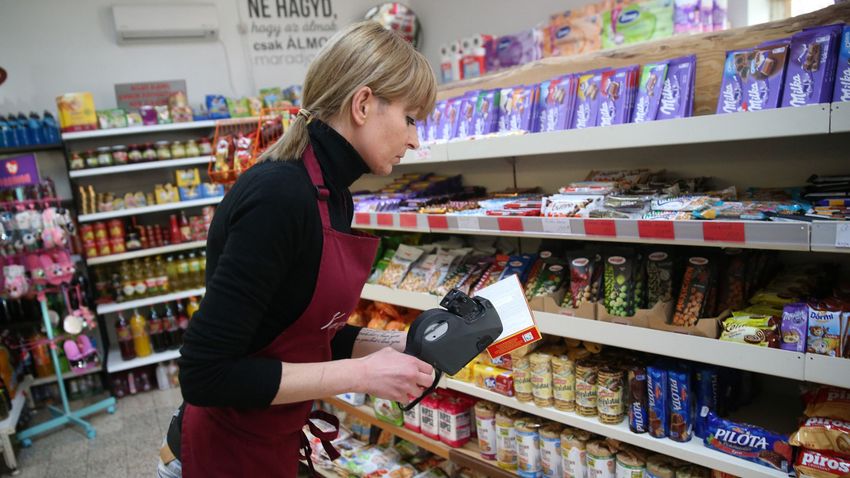Although the rate of monetary deterioration is still skyrocketing in this country, it may already be close to its peak, and in the case of certain foodstuffs, the prices have started to fall. We show you the details!
Trappist cheese costing 7,000-8,000 forints per kilo, small boxes of sour cream sold for 400-500 forints, butter for 1,000 forints - these are just some of the food prices that customers have had to face for months. The inflation that has been unleashed for more than a year, especially the drastic increase in the price of food, has a severe impact on Hungarian households, since a large part of their consumer basket is made up of food-related products. That is why the public is impatiently waiting for when the rate of currency deterioration will finally slow down, when it will be possible to buy cheaper in stores. In this regard, the latest developments can give some cause for cheerfulness, according to which the price competition between the large supermarket chains seems to be starting, of which the customers can be the clear winners.
Although the inflation data of the Central Statistical Office still show a brutal picture in an annual comparison, in a monthly comparison it can already be read that the rate of monetary deterioration may finally begin to decrease. In February, consumer prices were on average 25.4 percent higher than a year earlier, but the increase in food prices was much higher, 43.4 percent.
The analyst who previously spoke to Mandiner put the expected turnaround in food price increases for March. Dávid Hollósi, managing director of MKB Bank and Takarékbank's agricultural and food industry business, said:
"In the case of products with a high level of processing and a long warranty period, prices may still increase, because the raw material in the products available now is made at an even cheaper price level. But on average, it can be said that the drastic rise in prices will stop around March."
Based on the KSH data series, it appears that the expert certainly correctly predicted the turning point, but this will be revealed when the statistical data comparing March with February and April with March is released.
A few weeks ago, the majority of stores started the price reduction with butter, so in the stores of the larger supermarket chains it is now possible to buy butter in a 100-gram package for less than HUF 400 - it is true that there are places where the price of only the 60 percent fat content has dropped significantly - which last saw fourteen there was an example months ago according to the average flows of the KSH. And after the price of butter, in recent days and weeks, the "normalization" of the runaway cheese shops has also begun. For example, in the first two weeks of March, Spar offered a variety of cheeses at a discount of between 16 and 36 percent; Aldi and Lidl, which announced a 20-25 percent price reduction, and among the domestic ones, CBA and Coop also - among others - advertise their favorable prices with cheese. Among the latter, CBA informed MTI that
that he was able to reduce the price of butter and Trappist cheese because the suppliers reduced their transfer prices, and he passed on the entire discount to the customers.
On the part of the retail chain, they also emphasized that if the purchase price of new product lines falls, the resulting advantage will be applied in full in their consumer prices.
However, looking at the dairy products, it can be stated: not only the mentioned ones, but also cream, for example, calls for an immediate price reduction, since it also costs almost twice as much as it did more than a year ago. According to KSH's consumer price table, a small box of 20 percent sour cream cost HUF 381 at the end of last year, although looking at the price tags, it seems that the average price was mainly due to private label products. However, there are signs of progress here as well, for example, in Príma's latest discount newspaper, 20 percent sour cream from one of the domestic brands was already offered at a price of less than HUF 2,000 per kilo.
The next big question is, if the government does not extend the food price freeze valid until April 30, how much will you have to pay for granulated sugar, flour, cooking oil, pork legs, chicken, 2.8 percent long-lasting milk, eggs, and for potato chips.
Staying with dairy products, it is worth comparing fresh and preserved milk, since their prices moved together for a long time, until the price cap was ordered, but since the official price of UHT milk was made, the value of the two types of products has sharply separated from each other - which of course affects customer habits and thus the entire market rearranged. In January of this year, a liter of 2.8 percent pasteurized fresh milk cost HUF 557 on average, while long-lasting milk only cost HUF 298. The rate of increase in the price of the former product also attracted the attention of the GVH separately, because according to the authority, it is conceivable that competition on the domestic market of milk and milk products could be distorted or limited. The office therefore launched an accelerated official investigation into the case.
Source: Mandiner weekly
Featured image: MN/Róbert Lang













